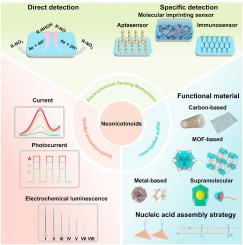Our official English website, www.x-mol.net, welcomes your feedback! (Note: you will need to create a separate account there.)
Electrochemical sensing mechanisms of neonicotinoid pesticides and recent progress in utilizing functional materials for electrochemical detection platforms
Talanta ( IF 6.1 ) Pub Date : 2024-03-16 , DOI: 10.1016/j.talanta.2024.125937 Longhua Ding , Jiawei Guo , Shu Chen , Yawen Wang
Talanta ( IF 6.1 ) Pub Date : 2024-03-16 , DOI: 10.1016/j.talanta.2024.125937 Longhua Ding , Jiawei Guo , Shu Chen , Yawen Wang

|
The excessive residue of neonicotinoid pesticides in the environment and food poses a severe threat to human health, necessitating the urgent development of a sensitive and efficient method for detecting trace amounts of these pesticides. Electrochemical sensors, characterized by their simplicity of operation, rapid response, low cost, strong selectivity, and high feasibility, have garnered significant attention for their immense potential in swiftly detecting trace target molecules. The detection capability of electrochemical sensors primarily relies on the catalytic activity of electrode materials towards the target analyte, efficient loading of biomolecular functionalities, and the effective conversion of interactions between the target analyte and its receptor into electrical signals. Electrode materials with superior performance play a crucial role in enhancing the detection capability of electrochemical sensors. With the continuous advancement of nanotechnology, particularly the widespread application of novel functional materials, there is paramount significance in broadening the applicability and expanding the detection range of pesticide sensors. This comprehensive review encapsulates the electrochemical detection mechanisms of neonicotinoid pesticides, providing detailed insights into the outstanding roles, advantages, and limitations of functional materials such as carbon-based materials, metal-organic framework materials, supramolecular materials, metal-based nanomaterials, as well as molecular imprinted materials, antibodies/antigens, and aptamers as molecular recognition elements in the construction of electrochemical sensors for neonicotinoid pesticides. Furthermore, prospects and challenges facing various electrochemical sensors based on functional materials for neonicotinoid pesticides are discussed, providing valuable insights for the future development and application of biosensors for simplified on-site detection of agricultural residues.
中文翻译:

新烟碱类农药的电化学传感机制及电化学检测平台功能材料的最新进展
环境和食品中新烟碱类农药的过量残留对人类健康构成严重威胁,迫切需要开发灵敏、高效的方法来检测痕量此类农药。电化学传感器具有操作简单、响应快速、成本低廉、选择性强、可行性高等特点,在快速检测痕量目标分子方面具有巨大潜力,受到人们的广泛关注。电化学传感器的检测能力主要依赖于电极材料对目标分析物的催化活性、生物分子功能的有效负载以及目标分析物与其受体之间相互作用有效转化为电信号。性能优越的电极材料对于增强电化学传感器的检测能力起着至关重要的作用。随着纳米技术的不断进步,特别是新型功能材料的广泛应用,拓宽农药传感器的适用性、扩大检测范围具有重要意义。这篇全面的综述概括了新烟碱类农药的电化学检测机制,详细介绍了碳基材料、金属有机骨架材料、超分子材料、金属基纳米材料等功能材料的突出作用、优点和局限性。作为分子印迹材料、抗体/抗原和适体作为新烟碱类农药电化学传感器构建中的分子识别元件。此外,还讨论了基于新烟碱类农药功能材料的各种电化学传感器面临的前景和挑战,为简化农业残留现场检测的生物传感器的未来开发和应用提供了宝贵的见解。
更新日期:2024-03-16
中文翻译:

新烟碱类农药的电化学传感机制及电化学检测平台功能材料的最新进展
环境和食品中新烟碱类农药的过量残留对人类健康构成严重威胁,迫切需要开发灵敏、高效的方法来检测痕量此类农药。电化学传感器具有操作简单、响应快速、成本低廉、选择性强、可行性高等特点,在快速检测痕量目标分子方面具有巨大潜力,受到人们的广泛关注。电化学传感器的检测能力主要依赖于电极材料对目标分析物的催化活性、生物分子功能的有效负载以及目标分析物与其受体之间相互作用有效转化为电信号。性能优越的电极材料对于增强电化学传感器的检测能力起着至关重要的作用。随着纳米技术的不断进步,特别是新型功能材料的广泛应用,拓宽农药传感器的适用性、扩大检测范围具有重要意义。这篇全面的综述概括了新烟碱类农药的电化学检测机制,详细介绍了碳基材料、金属有机骨架材料、超分子材料、金属基纳米材料等功能材料的突出作用、优点和局限性。作为分子印迹材料、抗体/抗原和适体作为新烟碱类农药电化学传感器构建中的分子识别元件。此外,还讨论了基于新烟碱类农药功能材料的各种电化学传感器面临的前景和挑战,为简化农业残留现场检测的生物传感器的未来开发和应用提供了宝贵的见解。



























 京公网安备 11010802027423号
京公网安备 11010802027423号